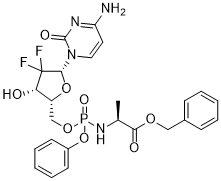| Cas No.: | 840506-29-8 |
| Chemical Name: | Acelarin |
| Synonyms: | Acelarin;NUC1031;NUC-1031;XCL1K2T28K;Fosgemcitabine palabenamide, p(rs)-;AcelarinNUC1031;s9649;DB15057;SB16795;L-Alanine, N-(2'-deoxy-2',2'-difluoro-p-phenyl-5'-cytidylyl)-, phenylmethyl ester;Benzyl (2S)-2-((((2R,3R,5R)-5-(4-amino-2-oxo-pyrimidin-1-yl)-4,4-difluoro-3-hydroxy-tetrahydrofuran-2-yl)methoxy-phenoxy-phosphoryl)amino)propanoate |
| SMILES: | C[C@H](NP(OC1=CC=CC=C1)(OC[C@H]2O[C@@H](N3C=CC(N)=NC3=O)C(F)(F)[C@H]2O)=O)C(OCC4=CC=CC=C4)=O |
| Formula: | C25H27F2N4O8P |
| M.Wt: | 580.4745 |
| Purity: | >98% |
| Sotrage: | 2 years -20°C Powder, 2 weeks 4°C in DMSO, 6 months -80°C in DMSO |
| Description: | Acelarin (NUC-1031) is a ProTide transformation and enhancement of the widely-used nucleoside analogue, gemcitabine. |
| Target: | EC50:0.2 nM (DNA synthesis inhibitor)[1] |
| In Vivo: | The ProTide demonstrates a significant reduction in tumor size against pancreatic xenograft models compared with the gemcitabine treated group, and less adverse effects on body weight, indicating a better safety profile. Data strongly suggests that the ProTides are not reliant on kinases or nucleoside transporters to exert their activity inside tumor cells and remain stable in the presence of deaminases. The ProTide NUC-1031 is currently advancing through phase I/II clinical studies and has already generated strong pharmacokinetic data that confirm significantly higher intracellular levels of gemcitabine triphosphate, together with promising early efficacy signals and a favorable safety profile. The phosphoramidate chemistry is potentially a great source of new and very effective anticancer agents, bringing a considerable array of advanced treatments specifically designed to overcome cancer resistance mechanisms that will benefit a greater proportion of patients[1]. |
| In Vitro: | Gemcitabine is a nucleoside analogue commonly used in cancer therapy but with limited efficacy due to a high susceptibility to cancer cell resistance. The addition of a phosphoramidate motif to the gemcitabine can protect it against many of the key cancer resistance mechanisms. A series of gemcitabine phosphoramidate prodrugs are synthesized and screened for cytostatic activity in a range of different tumor cell lines. Among the synthesized compounds, NUC-1031 is shown to be potent in vitro. |
| Cell Assay: | NUC-1031(5.0 mg) is dissolved in DMSO (0.050 mL) and D2O (0.15 mL). After recording the control 31P NMR at 37 °C, a previously defrosted human, rat, or dog serum (0.30 mL) is added to the sample, which is next submitted to the 31P NMR experiments at 37°C. The spectra are recorded every 30 min over 13 h. 31P NMR recorded data are processed and analyzed with the Bruker Topspin 2.1 program[1]. |
| Animal Administration: | Balb/c nude mice are female, six to eight week old, with the weight of 20 ± 2 g. They are intraperitoneally given NUC-1031 (i.p 0.228 mmol/kg, 132.3 mg/kg, 2×/WK) or vehicle for 2 weeks. NUC-1031 is dissolved in 40% Captisol solution. (40% Captisol is prepared by dissolving 20mg of Captisol with pure water, and made the final volume 50 mL. The solvent is filtered with 0.22 μm filter). Mice are monitored daily for body weight change and clinical symptoms for 2 weeks[1]. |

 To enhance service speed and avoid tariff delays, we've opened a US warehouse. All US orders ship directly from our US facility.
To enhance service speed and avoid tariff delays, we've opened a US warehouse. All US orders ship directly from our US facility.




















